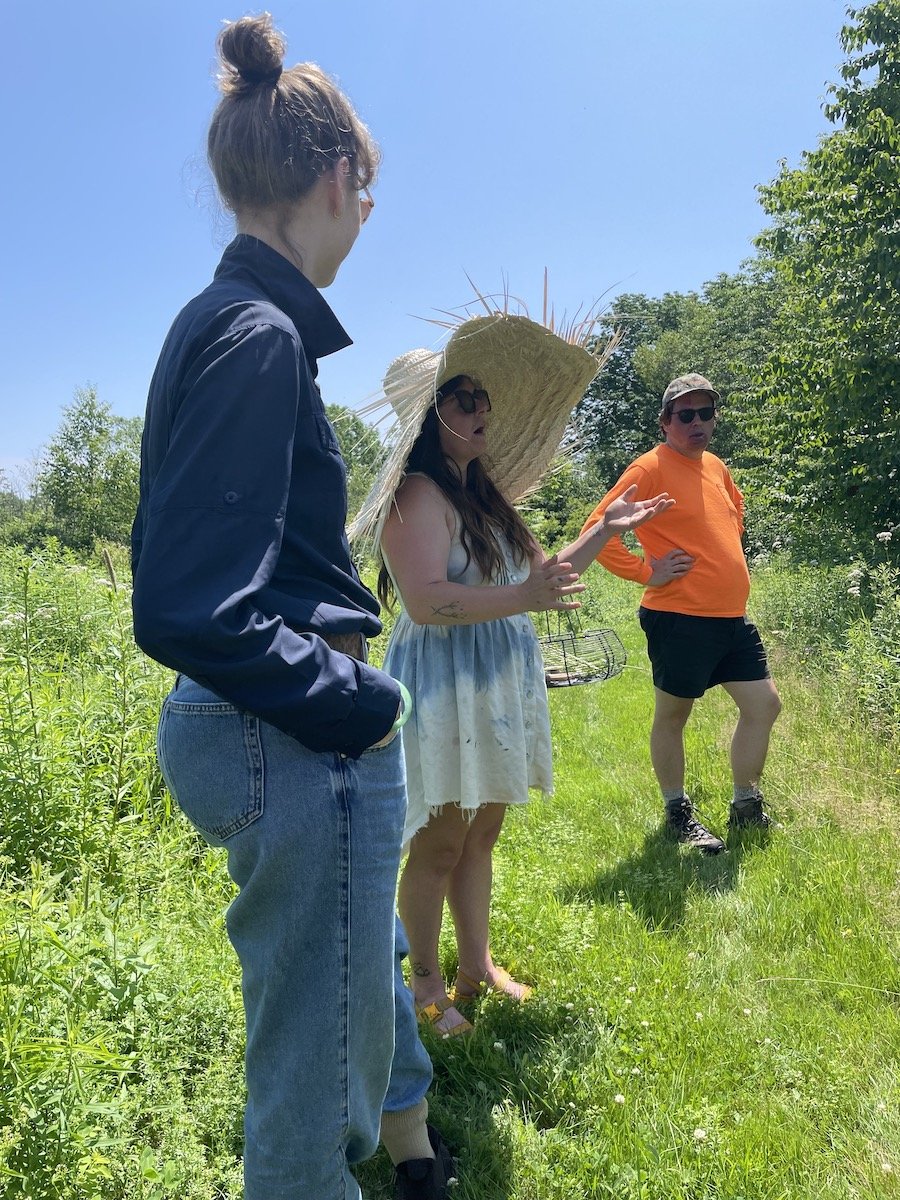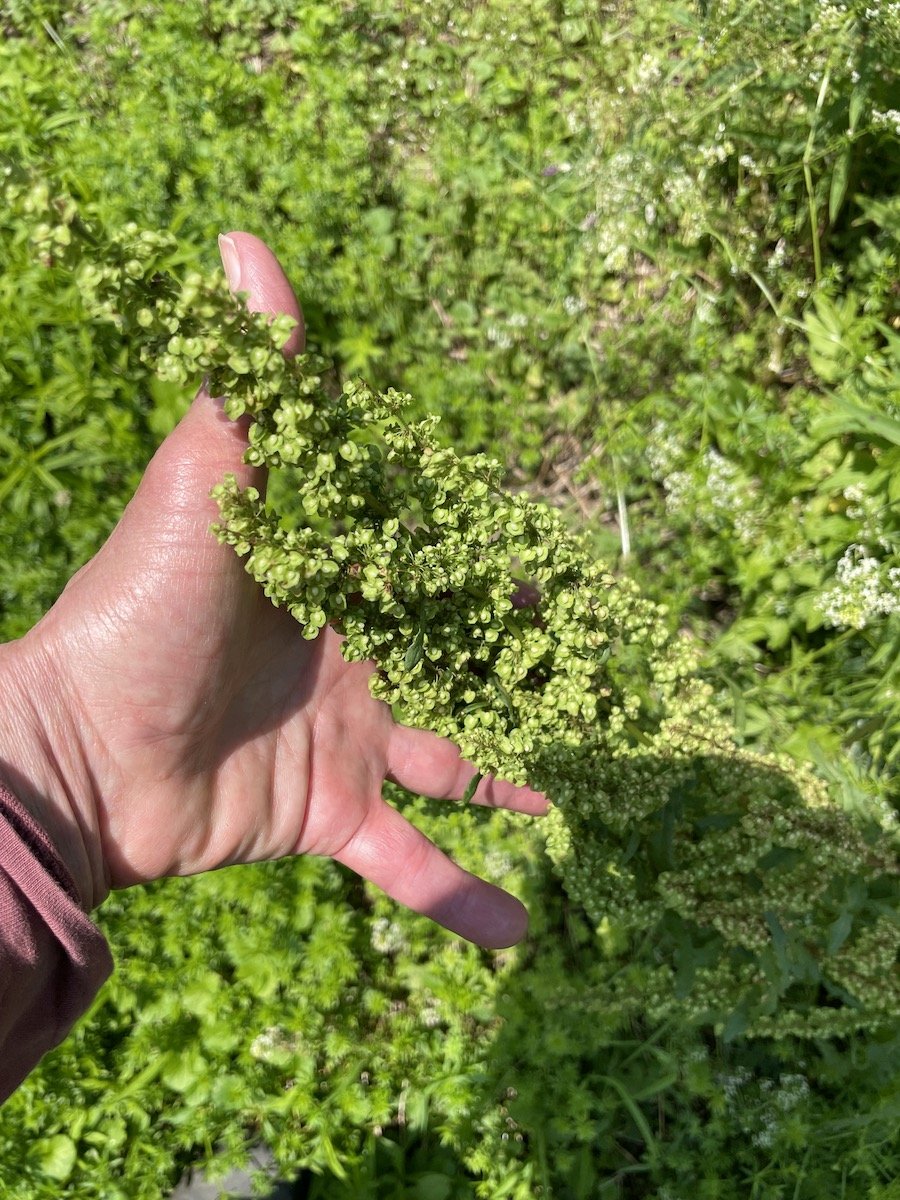
Working
Walkabout
There’s always something that needs work - some invasive multiflora that’s sprung up in the alders, or a barberry in the middle of the field. I seldom go out without a sickle and pruners just in case - because I am happiest when I’m exploring and making space for native species.
And I’m grateful to the people who work with me - Steve Henderson at Coastal Home and Garden, Didier Bonner-Ganter of ForTree Inc,, my neighbor John Pincince who cares for the apple trees, and my assistant, Bethany Engstrom, who’s as capable out in the field as she is in the studio, and whose tech skills make it possible for me to share on this website all that goes on around here.
Foraging for Edibles
I wasn’t complaining about the rain — I like the cool and the fog that it brings, and appreciated not having to be out watering the lettuces and peas. But after 10 straight days of it, it was nice to see the sun come out for the foraging workshop here on July 5.
I’d invited Rachel Alexandrou, forager and wild food cook, to lead a group of us around my property here in midcoast Maine, to see what we might learn about the edible and medicinal properties of the plants that grow here. By way of backstory, I should tell you that when I bought these 2.5 acres in 2006, this was just a lot of over-mowed field, with one red maple and one white ash left to their own devices. Along the property lines, in parallel lines of white ash, red maple, and red oak, I found multiflora rose, barberry, and Asian bittersweet in, around and up, strangling the trees. Since then I’ve helped the habitat restore itself by keeping an eye out for controlling the invasives, so that now where there was open field, there is a birch grove, a vigorous blackberry patch, and a pond. White pine, black walnut, and many, many alders have volunteered themselves.
So Rachel and our group expected we would find some edibles. But even I was astonished by the variety. I’ll list just the forbs and trees that Rachel taught us how to identify: ox-eye daisies, ground ivy, curly dock, black cherry, red oak, blackberries, goutweed, milkweed, sweet fern, burdock, valerian, white pine, wild mint, cattails, bayberry, plantain, native jewelweed, goldenrod, ladies’ bedstraw, purple vetch, crabapple, and my favorite, shadbush. At this moment of writing, the catbird is scarfing up shadbush berries like there’s no tomorrow.
Ground ivy, or creeping Charlie, or gill-over-the-ground, Glechoma hederacea, was already one of my favorites. Native bees love the early purple flowers. It makes a vigorous green mulch, and is a good pot herb. Like its relatives the other mints, ground ivy has a square stem that helps identify it. Our taste tests proved that where it grows up near the asparagus and sweet fern, the leaf has a flavor reminiscent of spiced lamb. Down in the orchard, its flavor is distinctly more minty than meaty.
There were as many more that we didn’t have time to talk about, including St. John’s wort, heals- all, lemon balm, chokecherry and high bush cranberry. Looking at the lists, I see that there is only one that I planted myself - the lemon balm that came from the Hannaford’s back in 2008, and has self-seeded reliably every year since. Everything else has been a gift of the land. Each one has its own story, and its list of properties that are shared with animals including us, with other plants, and with the soil.
For instance, curly dock, Rumex crispus, is a member of the smartweed/buckwheat family. I first noticed it in large amounts when the meadow was young, and saw its numbers diminish as I allowed goldenrod and asters to dominate. But with an annual fall mowing, it will reappear, especially along the margins. I’ll look for the young leaves to add to salads because I love a tart taste in the spring. The seeds are edible, too. Rachel noted that once mature, they can be ground into flour and used for pancakes with a buckwheat flavor. Curly dock also has many pharmaceutical uses, and is high in iron and vitamins C and A. As always, you should research any plant carefully before jumping in for a cure. Often one herb needs to be balanced with another to mitigate its effect, and this is true of buckwheats as well.
Burdock, with its deep taproot and huge leaves, helps prevent washouts along my driveway. Cattails, though they are absent from the pond this year, will be back and provide some very good eating now that I know what to do with them. The goldfinches will use them as nesting materials. Bayberry candles give us warmth, ladies’ bedstraw once served as a fragrant filler for mattresses, and there’s valerian for sweet dreams (or restless sleep depending on your reaction to it). Plantain and orange jewelweed are instant soothers for poison ivy, cuts, and I would assume, brown tail moth itch as well.
After our walkabout, Rachel treated us to bayberry soda sipped with straws made from knotweed, milkweed blossoms, and cattail corn dogs. And we had foraged more than plants. A walk like this, where there is so much to learn, provides a sense of balance and healing. It’s a phenomenon that I will explore in future posts. I’m also curious to learn more about the abundance of water that flows across and under this place, waterways that so define what soil settles where, and which plants grow in what areas, and how necessary it is to our well-being and to life on earth.
You may have recognized some of our edibles as noxious weeds that you spend a lot of time getting rid of. Much depends on where they are, and where you are, and your vision for your garden. I’d love to hear from you about your experiences with growing things.
With many thanks to Rachel for her commitment to foraging and wild foods! You can find her on Instagram @giantdaughter.





